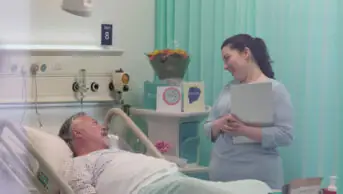
JL / Shutterstock.com
Mary visits her community pharmacy regularly to collect her medicines, but one week she does not come in. Eventually, a relative visits the pharmacy to ask for Mary’s prescription, revealing that she had been admitted to hospital with heart problems. They explain that Mary has now returned home, but she has been prescribed different tablets.
Community pharmacists are often faced with this scenario: not being aware that a patient has been admitted to hospital and not being informed that their medicines have changed when they have been discharged.
“I’d have to drop everything to ensure that the all-important first prescription after discharge was correct,” explains Una Harding, a pharmacist at Day Lewis Pharmacy in Aintree, Liverpool.
While some GP surgeries are proactive and inform community pharmacies of any changes made when the patient is discharged, others are slower and frequently lack the capacity to check hospital discharges in a timely way.
“I used to spend literally hours every week making phone calls to local [GP] surgeries or chasing faxes from the hospital pharmacy to make sure that we’d incorporated any changes in the prescription,” says Harding.
“If the [GP] receptionist was too busy to help or the surgery was closed, that was it. Sometimes it was guesswork.”
However, for Harding, this changed in January 2018 when community pharmacists in the Cheshire and Merseyside Health and Care Partnership — which comprises 11 hospital trusts and 635 community pharmacies — began participating in the transfers of care around medicines (TCAM) service. TCAM was first piloted in Newcastle in 2014 and enables hospital trusts to send secure online messages to community pharmacists to identify patients in need of extra help with their medicines after leaving hospital.
Large-scale problem
This extra help provided by the TCAM service is frequently needed. On average, data show that four in ten medicines are discontinued in hospital, while 60% of people with chronic disease have three or more medicines changed during a hospital stay[1],[2]
.
NHS England now sees TCAM, which encompasses several digital platforms (see Box 1), as an essential way to achieve medicines optimisation and improve patient safety, and has commissioned Academic Health Science Networks (AHSNs) to roll out the service to 50% of acute NHS trusts in England by the end of 2020. The new community pharmacy contract for England, which was unveiled in July 2019, laid out plans to introduce a medicines reconciliation service as part of TCAM by the end of March 2021, to ensure that changes in medicines made in secondary care are implemented after patients are discharged from hospital.
Box 1: Transfers of care around medicines platforms in use
Refer-to-Pharmacy was tailor-made for East Lancashire Hospitals NHS Trust by the healthcare IT solutions company Cegedim Rx. Since the scheme launched in October 2015, 28,000 patients have been referred to their community pharmacist for post-discharge support. Since March 2017, all community pharmacies receive a hospital admission notification, enabling them to stop dispensing medicines, including blister packs, while patients are in hospital.
The system has prevented at least 1,200 prescriptions from being dispensed unnecessarily in the two years since March 2017, according to an audit published in June 2019, saving £12,000 (based on an estimate of £10 per prescription) and cutting community pharmacist workload by at least 400 hours per year. More than 250 incidents of harm prevention have been reported as a result of community pharmacists spotting prescribing errors on the first prescription after discharge.
PharmOutcomes has had the most comprehensive roll out, with 55,000 patients referred to community pharmacies — 33,000 of which have been acted on. Hospitals can send admission notifications out for every patient automatically, once the patient has given consent.
The savings made through a reduction in hospital readmissions are estimated to be £11m over the two years to June 2019 in Cheshire and Merseyside alone.
AHSNs originally projected that TCAM would result in savings of £28.8m in 2019/2020, based on a reduction in length of stay of 113,406 days and 2,007 fewer readmissions. However, the number of referrals in 2018/2019 exceeded what was expected, which the AHSNs said may have saved the health economy more than £50m.
Similar services exist or are being developed in Wales and Scotland (see Box 2).
Box 2: Transfer of information in Wales and Scotland
In Wales, the discharge medicines review (DMR) service has been operational since November 2011. At the hospital end, the system uses the medicines transcribing and e-discharge model, which records a list of a patient’s prescriptions and adds them to an electronic discharge advice letter. This letter is then sent to the patient’s GP via the Welsh Clinical Communications Gateway. The service has been rolled out to the 703 community pharmacies in Wales that have the Choose Pharmacy platform, but it is not yet in every hospital or hospital ward.
However, the results of a four-year evaluation of the scheme in Wales show that only a quarter of community pharmacies are actively checking patients’ medicines after discharge from hospital. Researchers from Cardiff University, who presented their findings at the International Pharmaceutical Federation Congress in Glasgow on 4 September 2018, found just 0.7% of potential DMRs commissioned were undertaken over four years and that, on average, 25% of eligible pharmacies claimed for a DMR each month.
In Scotland, the pharmacy care record is one of two main avenues for sharing information between secondary care and primary care. The other is an electronic clinical portal.
“These are at different stages of deployment in different areas,” explains Matt Barclay, director of operations at Community Pharmacy Scotland. “Our members will work with the Scottish government, health board partners and other stakeholders to support universal principles that can be used to deliver safe systems for the transfer of information across Scotland.
“We will also look to see what is happening in other areas of UK to see if there are learnings we can apply,” he adds.
Problems at discharge
Phil Jennings, a Merseyside GP and former deputy medical director of NHS England (Cheshire and Merseyside), acknowledges that problems often occur at discharge. “As a practising GP, I can immediately recognise the potential for medication errors to occur when patients are discharged from hospital,” he says. “I have frequently been involved in cases where medicines are missing or duplicated with another in their class, or where medicines have been stopped or started [when a patient is discharged] without an obvious reason,” he adds.
According to the AHSNs, unintentional changes or an error because of miscommunication affect up to 70% of patients during transfer of care.
As well as providing a way for hospital and community pharmacists to communicate, TCAM saves money
Medicines safety when transferring between care settings has long been been a concern. A 2007 study found that 6.5% of emergency admissions are the result of adverse drug reactions, of which 72% are avoidable[3]
. In July 2012, the Royal Pharmaceutical Society launched professional guidelines, titled ‘Keeping patients safe when they transfer between care providers — getting the medicines right’, which lay out the core principles underpinning the safe transfer of medicines information for a patient transferring between care providers in any setting[4]
. Further guidelines were issued by the National Institute for Health and Care Excellence in 2015[5]
.
“There is some debate about which TCAM [platform] is best,” says Hassan Argomandkhah, a senior clinical pharmacist, chair of a pharmacy local professional network in Merseyside and a pioneer of TCAM using PharmOutcomes, a web-based solutions platform already commonly used by community pharmacists (see Box 1). “But any fully automated system that enables hospital and community pharmacists to communicate, and provides community pharmacists with access to discharge notifications, is good enough,” she explains.
“It provides a community pharmacy with a fully auditable relationship with both vulnerable patients and hospital pharmacists 24/7.”
As well as providing a way for hospital and community pharmacists to communicate, TCAM saves money, not least in reducing the number of multicompartment compliance aids (i.e. blister packs) that are made up by community pharmacies and never used when patients are admitted to hospital.
Aintree University Hospital, which has 750 beds, discharges an average of 120–130 patients each day, “or 3,000–4,000 every month, of whom a proportion receive blister packs [multicompartment compliance aids],” notes Dave Thornton, assistant clinical director of pharmacy at Aintree University Hospitals NHS Foundation Trust.
When a patient is admitted to hospital, one or more of their existing prescribed blister packs will remain unused, with potential for a further blister pack to become unusable if their prescription changes after discharge. “That amounts to a huge waste of NHS funds and community pharmacists’ time,” says Emma Watson, critical care pharmacist at East Lancashire Hospitals NHS Trust, which introduced the TCAM platform ‘Refer-to-Pharmacy’ in 2014 (see Box 1).
But patient safety is a bigger issue than waste. “What you want to avoid is a situation where a blister pack [containing] the wrong medicines is delivered by a van driver to an exhausted 85-year-old who, as a direct result of this error, has to be re-admitted [to hospital] the next day,” says David Barker, engagement officer at Liverpool Local Pharmaceutical Committee.
And it is not just blister packs that can cause problems. “Take a patient who has their usual diuretic [medicine] held on admission to hospital due to acute kidney injury, with a plan for the GP to restart [after discharge],” says Thornton. “I would want the community pharmacist to be aware of this plan as soon as the patient is discharged.”
Steven Brice, assistant director of pharmacy at Newcastle upon Tyne Hospitals NHS Foundation Trust, says one recent example of a potentially hazardous post-discharge prescription was a patient prescribed dabigatran instead of warfarin in hospital, who nearly took both anticoagulant drugs when he returned home. Luckily, a TCAM service prevented this from happening.
Argomandkhah explains that during the years he worked as a community pharmacist, this type of error was common. “You’d have patients taking antiplatelet drugs that a cardiologist had decided were no longer needed, or an insulin dose wouldn’t be changed even though it was causing [hypoglycaemia].”
The active engagement of community pharmacists is essential in making TCAM work
Avoidable adverse drug reactions (ADRs) have been estimated to cost the NHS £98.5m per year[1]
. “We know that a number of patients are re-admitted to hospital following discharge, owing to ADRs and other problems with their medications,” says Julia Carthew, national medicines optimisation programme manager for the Wessex AHSN, which is the national lead for the AHSN medicines optimisation programme.
Barriers to implementation
Although the TCAM scheme is built on sound principles, there have been a number of stumbling blocks in implementing it widely. Clare Howard, clinical lead for medicines optimisation at Wessex AHSN, told The Pharmaceutical Journal in May 2019 that 55,000 patients had been referred to community pharmacy by hospitals after discharge in the past year, of which only 33,000 had been acted on by a community pharmacy. The active engagement of community pharmacists is essential in making TCAM work.
“However good the system, if community pharmacists do nothing, then nothing happens,” says Barker. “I get all the referrals [to community pharmacy], showing patients’ initials and age, I eyeball them to identify those that are still in the community pharmacy’s inbox. If there hasn’t been timely action, I give the pharmacy a ring,” he explains. “I’ll be providing support rather than a telling off.”
However, it is hospital trusts that are the main stumbling block to TCAM’s implementation across the country. By March 2018, TCAM schemes had been implemented in just 42 out of 152 acute trusts (28%). “It is a lottery. London has barely started [rolling out] the programme,” says Argomandkhah.
Interestingly, in TCAM’s case, the cost of introducing the system — which almost always uses existing computer systems and pharmacy skills — is very small and therefore can’t be blamed for its slow uptake. “If we prevent just two or three readmissions, we’ve covered the cost,” says Alistair Gray, clinical services lead pharmacist at East Lancashire Hospitals NHS Trust and a pioneer of the trust’s Refer-to-Pharmacy scheme.
As for the public response, Jonathon Holmes, senior policy analyst at the patients’ organisation HealthWatch, says that most people assume that hospital and community pharmacy already communicate. “[TCAM is] a positive scheme that has the potential to reduce readmission rates and divert pressure from hospitals and primary care providers while expanding the role of the community pharmacist,” he says.
If anything, he adds, “more needs to be done to highlight the expertise of community pharmacists and the range of services they can offer”.
There are suggestions that a reward and incentive programme for community pharmacists similar to the Quality and Outcomes Framework in GP practices might encourage a higher rate of participation in TCAM. Argomandkhah says Cheshire and Merseyside, where all trusts and community pharmacies are engaged in TCAM, could provide a perfect location for a pilot scheme to test the ambition of the new community pharmacy contract to introduce a medicines reconciliation service.
However, others are concerned that financial incentives could give the wrong message. “This isn’t a referral requiring a specific task to be carried out every time,” argues Thornton. “It’s a transfer of information that the community pharmacist can use as necessary to improve patient safety.”
Recognising the benefits
The real obstacle, according to Gianpiero Celino, product director at pharmacy software provider Cegedim Rx, which developed the Refer-to-Pharmacy scheme for the East Lancashire Hospitals NHS Trust, is that “so many people are oblivious to the benefits that this communication system brings”.
“If you don’t have the system in place, it’s hard to appreciate its value,” says Watson.
Gray agrees: “Most people working in [NHS] trusts simply don’t have a strong opinion on the need for this system, or [they] are naive to the benefits.”
As for community pharmacists, Harding acknowledges that, before implementation, she had not realised how significantly the scheme would change her working life. “I couldn’t believe how TCAM solved so many problems,” she says.
For all these reasons, progress — even with the support of the AHSNs — will occur “only when those who see the value are prepared to keep going despite the obstacles”, says Argomandkhah.
“It seems ludicrous that there has been so little integration between hospital and community pharmacy in the UK — and in most of the rest of the world — and that only now are people speaking out about its benefits,” says Watson.
References
[1] Elliott RA, Camacho E, Campbell F et al. 2018 Available at: http://www.eepru.org.uk/wp-content/uploads/2018/02/eepru-report-medication-error-feb-2018.pdf (accessed October 2019)
[2] Himmel W, Kochen MM, Sorns U & Hummers-Pradier E. Int J Clin Pharm Th 2004;42(2):103-9. doi: 10.5414/cpp42103
[3] Patel H, Bell D, Molokhia Met al. 1998–2005. BMC Clin Pharmacol 2007;7:9. doi: 10.1186/1472-6904-7-9
[4] Royal Pharmaceutical Society. 2012. Available at https://www.rpharms.com/Portals/0/RPS%20document%20library/Open%20access/Publications/Keeping%20patients%20safe%20transfer%20of%20care%20report.pdf (accessed October 2019)
[5] National Institute for Health and Care Excellence. 2015. Available at: https://www.nice.org.uk/guidance/NG5 (accessed October 2019)


